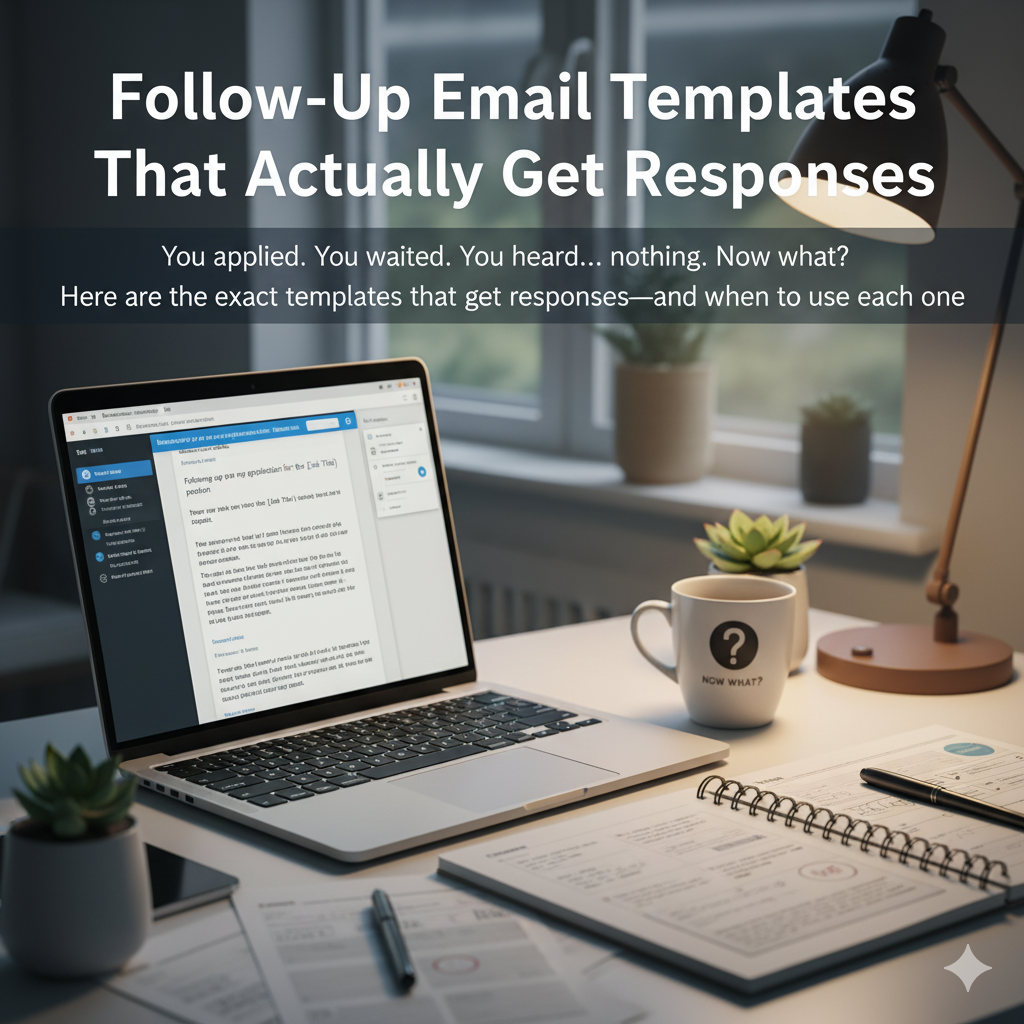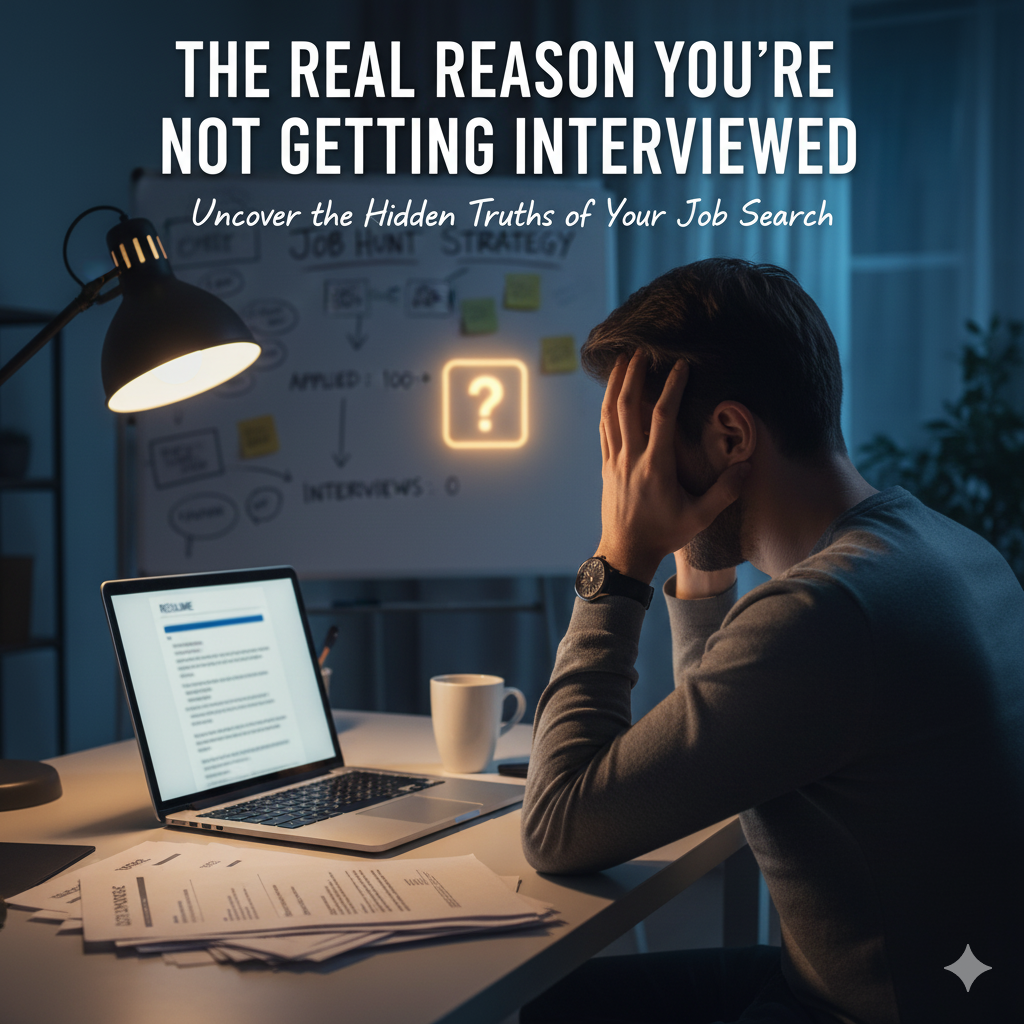
Follow-Up Email Templates That Actually Get Responses
You applied. You waited. You heard... nothing.
Now what?
Most job seekers either never follow up (and lose the opportunity) or send generic emails that get ignored.
Here are the exact templates that get responses—and when to use each one.
⏱️ TL;DR
Follow up 5-7 days after applying with a brief, value-focused email. Use our templates based on your situation: standard follow-up, after interview, after rejection, or when you have new information. Always keep it under 100 words. Jump to templates ↓
Quick Navigation
When to Follow Up (Timing Matters)
After Applying: Wait 5-7 business days
- Why: Gives them time to review applications
- Too early: You look impatient
- Too late: Position may be filled
After Interview: Send within 24 hours (thank you), then follow up after 7-10 days if no response
- Why: Shows you're interested and professional
- Thank you note: Always send same day or next morning
After Rejection: Wait 3-6 months before applying again
- Why: Shows you've grown/gained new skills
- Exception: If they say "apply again soon," do it in 1-2 months
After No Response to Follow-Up: One more try after 5-7 days, then move on
- Why: More than 2 follow-ups looks desperate
- Reality: If they haven't responded after 2 emails, they're not interested
The Follow-Up Formula
Every effective follow-up email has 3 parts:
- Remind them who you are (1 sentence)
- Add new value or context (1-2 sentences)
- Clear, easy ask (1 sentence)
Total length: 75-100 words max. Anything longer gets ignored.
Email Templates (Copy & Customize)
Template 1: Standard Follow-Up After Applying
When to use: 5-7 days after submitting application, no response yet
Subject line: Following up: [Job Title] application
Hi [Hiring Manager Name],
I applied for the [Job Title] position last week and wanted to follow up on my application.
I'm particularly excited about [specific aspect of the role or company]—it aligns perfectly with my experience in [relevant skill/achievement].
Is there any additional information I can provide to support my application?
Best,
[Your Name]
Why this works: Brief, shows genuine interest, offers to help
Customize: Replace brackets with specifics. Mention a recent company news item or project if relevant.
Template 2: Follow-Up When You Know They Viewed Your Resume
When to use: You have trackable links from Hiir.me and see they viewed your profile
Subject line: Quick question about [Job Title]
Hi [Hiring Manager Name],
I saw you viewed my profile for the [Job Title] position—thank you for taking the time!
I wanted to quickly share that I recently [completed relevant project/earned certification/achieved result] that's directly applicable to this role.
Would you like me to send additional details?
Best,
[Your Name]
Why this works: You know they're interested. Provides new information. Low-pressure ask.
Pro tip: Only use this if you actually have something new to share. Don't invent updates.
Template 3: Thank You After Interview
When to use: Within 24 hours of interview (ideally same day)
Subject line: Thank you - [Job Title] interview
Hi [Interviewer Name],
Thank you for taking the time to speak with me today about the [Job Title] role.
I'm even more excited about the opportunity after learning about [specific thing discussed in interview]. My experience with [relevant skill/project] would let me contribute immediately to [team goal/project discussed].
Please let me know if you need any additional information. I look forward to hearing from you.
Best,
[Your Name]
Why this works: Shows you were paying attention. Reinforces your fit. Professional and warm.
Timing matters: Send within 24 hours while you're fresh in their mind.
Template 4: Follow-Up After Interview (No Response)
When to use: 7-10 days after interview, they said "we'll be in touch" but haven't been
Subject line: Checking in - [Job Title] next steps
Hi [Interviewer Name],
I wanted to check in on the [Job Title] position we discussed on [date].
I remain very interested in the role and would welcome the opportunity to continue the conversation. Is there any update you can share on timing or next steps?
Thank you,
[Your Name]
Why this works: Polite, direct, easy to respond to. Shows continued interest without being pushy.
Template 5: When You Have New Information
When to use: You've achieved something relevant since applying/interviewing
Subject line: Update on my [Job Title] application
Hi [Hiring Manager Name],
I wanted to share a quick update relevant to my application for [Job Title].
Since we last spoke, I [completed certification/launched project/achieved result that's directly relevant to the role]. This experience strengthened my skills in [specific area relevant to job].
I'd love to discuss how this positions me to contribute to [team/project]. Are you available for a brief call?
Best,
[Your Name]
Why this works: Legitimate reason to reach out. Shows initiative and growth. Gives them new information to consider.
Examples of "new information":
- Earned relevant certification
- Completed a project in the same domain
- Published article on relevant topic
- Won award or recognition in your field
- Spoke at conference on relevant topic
Template 6: After Rejection (Future Opportunities)
When to use: 3-6 months after rejection, when you have new skills/experience
Subject line: Re-applying: [New Job Title] at [Company]
Hi [Hiring Manager Name],
I applied for [Previous Role] earlier this year and wanted to reach out about the [New Role] opening.
Since we last connected, I've [specific new skill/achievement/experience]. I believe this makes me a stronger candidate for your team, particularly for [specific aspect of new role].
Would you be open to a conversation?
Best,
[Your Name]
Why this works: Acknowledges previous rejection. Shows growth. Demonstrates genuine interest in the company.
Critical: Only do this if you've genuinely gained new relevant skills/experience.
What NOT to Do
❌ Don't: Be vague or desperate
Bad: "Just checking in! Any update? I really need this job!"
Why it fails: No value, looks desperate, puts pressure on them
❌ Don't: Send a novel
Bad: 500-word email explaining your entire career history
Why it fails: They won't read it. Hiring managers get 100+ emails per day.
❌ Don't: Follow up more than twice
Bad: 5 follow-up emails over 2 weeks
Why it fails: Looks desperate. If they haven't responded after 2 emails, they're not interested.
❌ Don't: Complain or be negative
Bad: "I haven't heard back and I'm confused about your hiring process..."
Why it fails: Burns bridges. Even if they're slow, complaining guarantees you won't get the job.
❌ Don't: Send the same template to everyone
Bad: "Dear Hiring Manager, I am writing to follow up on my application for the position at your company..."
Why it fails: Generic. Shows you didn't put in effort. Easy to ignore.
Subject Line Best Practices
Keep it clear and specific:
- ✅ "Following up: Marketing Manager application"
- ✅ "Thank you - Interview for Data Analyst role"
- ✅ "Update on my Software Engineer application"
Avoid:
- ❌ "Question"
- ❌ "Following up"
- ❌ "Hi!"
- ❌ All caps or excessive punctuation
Track Your Follow-Ups
Use a simple spreadsheet to track:
| Company | Applied Date | Follow-Up #1 | Follow-Up #2 | Response? |
|---|---|---|---|---|
| TechCorp | Nov 1 | Nov 8 | Nov 15 | No - Move on |
| StartupXYZ | Nov 3 | Nov 10 | - | Yes - Interview scheduled |
Why tracking matters:
- Prevents sending duplicate follow-ups
- Shows which companies engage
- Reminds you when to follow up next
- Helps identify patterns (which approaches work)
Pro tip: Use Hiir.me's application tracking dashboard to automatically track which companies viewed your resume and when to follow up.
The Response Rate Reality
Let's be honest about expectations:
- No follow-up: 5-10% response rate
- With follow-up: 15-20% response rate
- With trackable links (know they viewed): 30-40% response rate
Bottom line: Following up doubles your chances, but most companies still won't respond. That's normal.
What this means:
- Don't take non-responses personally
- Keep applying to multiple companies
- Focus on quality of follow-up, not quantity
- Track who responds and learn from patterns
Quick Decision Tree: Which Template to Use?
Situation → Template
- Applied 5-7 days ago, no response → Template 1 (Standard Follow-Up)
- You know they viewed your resume → Template 2 (Trackable Link Follow-Up)
- Just finished interview → Template 3 (Thank You)
- Interviewed 7-10 days ago, no update → Template 4 (Post-Interview Follow-Up)
- You have new relevant achievement → Template 5 (New Information)
- Rejected but want to try again later → Template 6 (Future Opportunity)
The Bottom Line
Following up is a numbers game with better odds:
- ✅ Most job seekers never follow up (your advantage)
- ✅ A brief, value-focused email doubles your response rate
- ✅ Timing matters: 5-7 days is the sweet spot
- ✅ Two follow-ups max, then move on
- ✅ Track everything so you learn what works
Your resume got you 80% of the way there. A smart follow-up can close the gap.
Take Action Now
- Copy the template that matches your situation
- Customize with specific details (company name, role, your relevant experience)
- Keep it under 100 words
- Send it 5-7 days after your last contact
- Track the response in your spreadsheet
Stop wondering if they saw your application. Start following up strategically.
Want to know for certain if employers viewed your resume? Try Hiir.me's trackable links →
Frequently Asked Questions
Should I follow up if the job posting says "no phone calls or emails"?
No. Respect their process. If they explicitly say no follow-ups, don't follow up.
However, if they just say "no phone calls," a polite email is usually fine.
What if I don't know the hiring manager's name?
Try to find it:
- Check LinkedIn (search "[Company] [Department] Manager")
- Look at the company's About/Team page
- Call the company and ask reception
If you truly can't find it, use "Hi [Department] Team" or "Hi Hiring Manager" as a last resort.
Should I follow up if I applied through a recruiter?
Yes, but follow up with the recruiter, not the company directly.
Wait 5-7 days, then send a brief email to the recruiter asking for an update.
What if they respond and say "we'll let you know"?
That's a polite rejection in most cases. Thank them and move on.
You can follow up one more time in 2-3 weeks if you want, but don't hold your breath.
Is it okay to follow up via LinkedIn message instead of email?
Email is usually better (more professional), but LinkedIn is fine if:
- You don't have their email address
- They're very active on LinkedIn
- You have a mutual connection
Keep the same format: brief, professional, value-focused.
Related Articles
- The Modular Resume System: Tailor in 10-15 Minutes - Optimize your resume before following up
- How to Know If Employers Viewed Your Resume - Track whether they actually saw your application
- Tool: ApplyScore - Check your resume match score before applying
Author Note: These templates are based on analyzing thousands of job applications and interviewing hiring managers about what gets their attention. They work because they're brief, add value, and make it easy to respond.
Last updated: November 7, 2025
